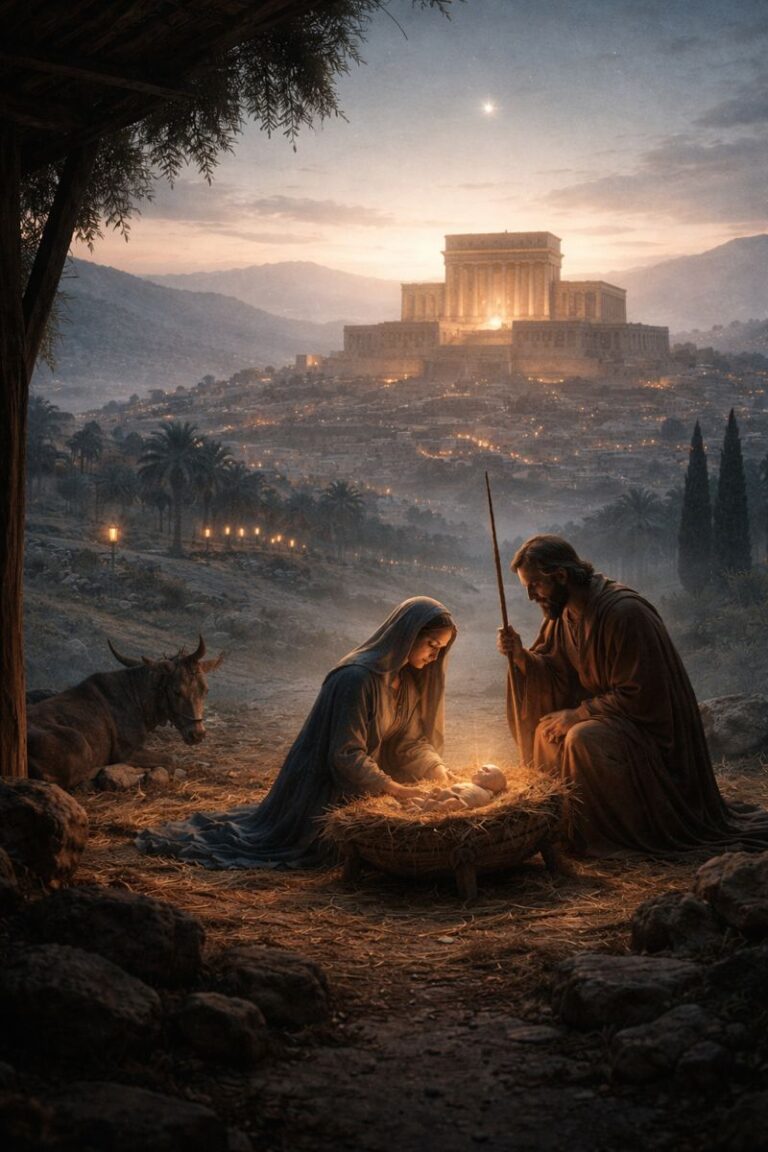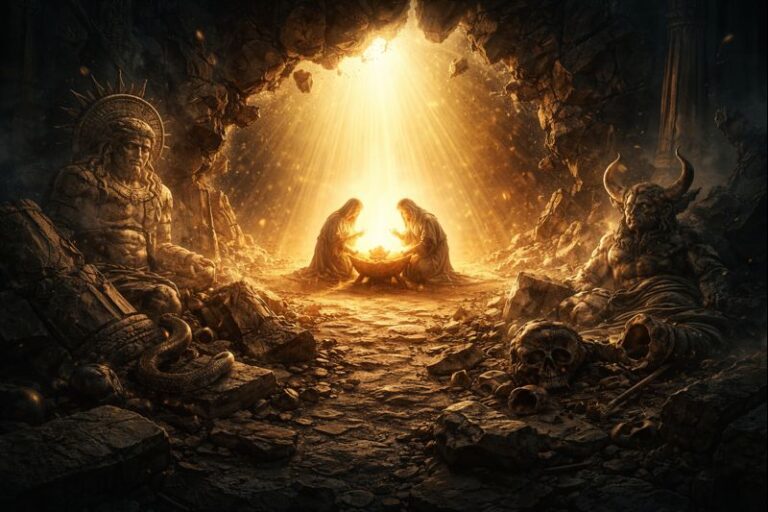
When Jesus prays to the Father in the Gospels, He does so as the Incarnate Son, fully God and fully man. His prayers are not signs of weakness or inequality, but expressions of true humanity. They reflect His relationship with the Father within the limitations of flesh and blood, taken on voluntarily to accomplish the redemption of mankind.
Yet Christ’s prayers do more than model dependence. They reveal His mission, not merely to forgive sin, but to lead those united to Him into eternal fellowship with Yahweh, where they will be glorified through their relationship with Him. In His High Priestly Prayer in John 17, Jesus says:
“I have given them the glory that you gave me, that they may be one as we are one” (John 17:22).
This is not poetic exaggeration. It is a clear expression of Christ’s intent to raise His followers into the glory that He shares with the Father, restoring and transforming them in the process.
Jesus’s Prayers as Revelation of His Mission
In John 17:1–2, Jesus prays:
“Father, the hour has come. Glorify your Son, that your Son may glorify you. For you granted him authority over all people that he might give eternal life to all those you have given him.”
Christ’s authority includes granting eternal life, an existence defined not merely by duration, but by nature: incorruptibility, righteousness, and unending communion with God. Later in the same prayer, He says:
“Father, I want those you have given me to be with me where I am, and to see my glory…” (John 17:24)
Though Christ is fully divine, He chose to humble Himself. As Paul writes in Philippians 2:6–8, though existing in the form of God, He did not cling to His divine status but emptied Himself, taking the form of a servant. Hebrews 2 says He was made for a little while lower than the angels, not because He lost divinity, but because He embraced full humanity. His prayers reflect this self-imposed humility and His desire to elevate those He redeems.
The Resurrection Body and the Nature of Glorified Transformation
Scripture consistently affirms the transformation of the faithful, not merely morally, but ontologically. Psalm 8 states that man was made “a little lower than the heavenly beings,” but destined to be crowned with glory and honor. Hebrews 2 applies this to Christ and, by extension, to all who belong to Him.
1 Corinthians 15 declares that believers will be raised with glorified, incorruptible bodies. Paul contrasts natural and spiritual bodies, perishable and imperishable, and concludes:
“Just as we have borne the image of the earthly man, so shall we bear the image of the heavenly man” (1 Corinthians 15:49).
Scholar David A. Burnett has demonstrated that Paul’s language in 1 Corinthians 15:39–42 draws from Deuteronomy 4:15–19, where the sun, moon, and stars are described in terms of divine beings. Paul is not making an abstract comparison. He is identifying the resurrection body with the glory and nature of celestial beings. Believers are not merely renewed humans. They are glorified and transformed, made fit for divine rule.
Burnett also shows that Paul’s reference to Genesis 15:5 in Romans 4:18 draws from Jewish interpretations in which Abraham’s descendants were not only numerous like the stars, but became like the stars—radiant, immortal, spiritual-class beings. Paul uses this framework to show that those united to Christ will experience this transformation through Him.
Deification in the Early Church
The early Church did not shy away from this truth. Athanasius famously wrote, “He was made man so that we might be made god.” This was not a claim to deity in the sense of identity with Yahweh, but a declaration of transformation. The faithful are not absorbed into the essence of God, but are elevated by grace into divine status, as sons and daughters, glorified beings, and members of the divine family.
In this sense, the faithful are called holy ones (hagioi in Greek, qedoshim in Hebrew), a term used throughout Scripture for divine beings in God’s presence (Deuteronomy 33:2, Psalm 89:5–7). Believers are not just called holy—they are made holy, transformed into beings fit for God’s eternal kingdom.
Resurrection and Embodied Divinity
The destiny of the faithful is not to escape physicality, but to be restored to it, fully transformed. In the New Creation, believers will be raised in glorified, incorruptible bodies. They will not be spirits floating in the heavens, but immortal and embodied rulers, bearing the image of the risen Christ.
This restored humanity is not a return to Eden, but something greater: humans made fit to dwell in the presence of Yahweh, participating in His rule and glory. Revelation 2:26–27 promises,
“To the one who conquers and who keeps my works until the end, to him I will give authority over the nations, and he will rule them with a rod of iron, as when earthen pots are broken in pieces, even as I myself have received authority from my Father.”
Revelation 3:21 continues,
“The one who conquers, I will grant him to sit with me on my throne, as I also conquered and sat down with my Father on His throne.” These are not metaphors for private spiritual experience. They are declarations of real, embodied rulership in the world to come.
Believers are not Yahweh, and they are not members of the Godhead, but they are divine beings, glorified sons and daughters, part of God’s restored council, and eternal rulers in His kingdom.
Conclusion
Christ’s prayers reveal His humility and His mission: to bring those given to Him into eternal fellowship with Yahweh, where they will be glorified through their relationship with Him. Those who are united with Christ are not merely forgiven, they are transformed. They are raised. They are made glorious. They become what God intended humanity to be from the beginning.
Not metaphorically. Not symbolically. Truly.
This is the destiny of the faithful: to become glorified, immortal, embodied divine beings who, through union with Christ, are transformed and appointed to rule in the New Creation forever.
Discussion Questions
- What do Jesus’s prayers in John 17 reveal about the future of those who follow Him?
- How does the biblical term elohim help clarify what believers become after death and resurrection?
- What does 1 Corinthians 15 teach about the nature of the resurrection body?
- How does David A. Burnett’s research deepen our understanding of Paul’s view of deification?
- How should the promise of glorified embodiment shape our understanding of salvation?
Want to Know More?
- Athanasius of Alexandria, On the Incarnation – The classic early Christian defense of the Incarnation and human transformation
- Kallistos Ware, The Orthodox Way – A rich summary of Orthodox teaching on salvation, theosis, and the Christian life
- David A. Burnett, “A Neglected Deuteronomic Scriptural Matrix for the Nature of the Resurrection Body in 1 Corinthians 15:39–42” – A study linking Paul’s resurrection theology to OT divine imagery
- David A. Burnett, “So Shall Your Seed Be” – An article showing how Paul uses early Jewish deification traditions in Romans 4
- David Litwa, We Are Being Transformed – A scholarly examination of deification in Paul’s theology
- N.T. Wright, The Resurrection of the Son of God – The definitive modern study on the meaning and implications of bodily resurrection in early Christianity




